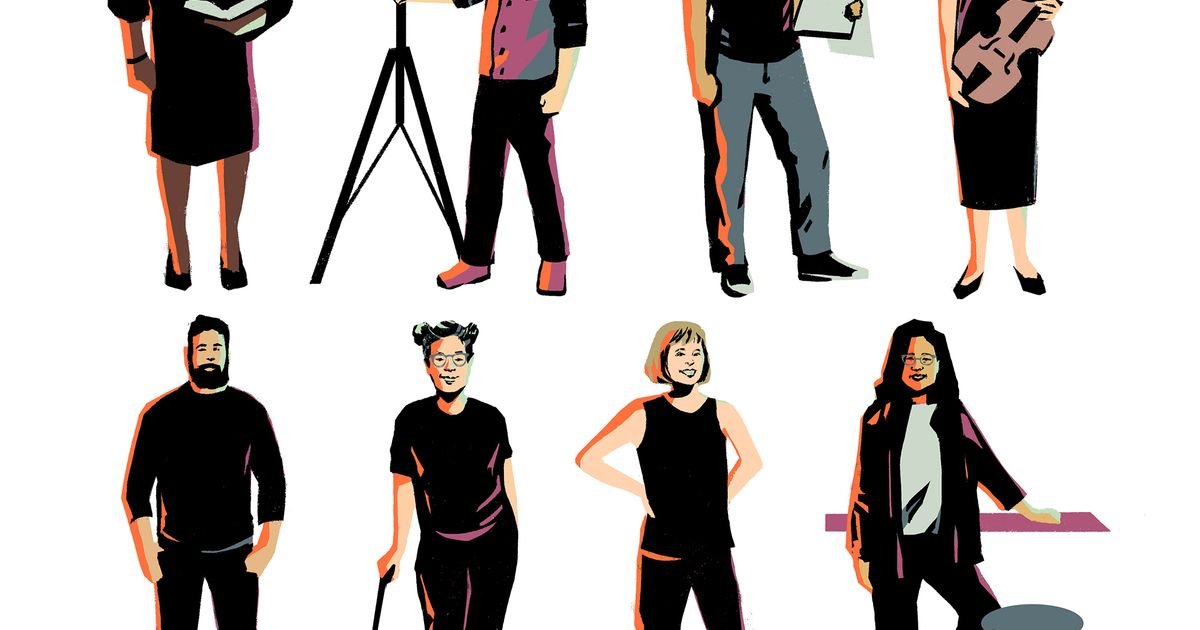Editor’s note: This story is part of our Affordability for Artists package, which explores the impact of Seattle’s soaring cost of living on the local arts scene, why it matters and what may help.
There are a thousand different ways to be an artist. For some, it’s a viable full-time career. But according to The Seattle Times 2024 Affordability for Artists Survey, that’s become increasingly difficult in ever-expensive Seattle. Here are eight creatives, in their own words, on how they make it work.
Kaitlin McCarthy (37)
Dance artist, teacher, journalist
Income: about $11,000 (relies on spousal support)
“In the past decade, dancers have advocated for pay to be the standard expectation and now even low-budget projects are prioritizing dancer pay more. But the cost of living is much, much higher now, so even with this advocacy we cannot match the cost of living. And if you are a dance maker, you are doing it all. You aren’t just making art. You are your own production, promotion, administrative, fundraising team. It’s exhausting and if you don’t have spousal or family support, no matter how much you hustle, you cannot make a sustainable living. Even highly lauded and beloved local choreographers struggle to live on their art alone.”
Webster Crowell (52)
Filmmaker, animator; supplements income with art installation, exhibition design, gallery management
Income: about $57,000 (roughly half of that film work, but “each year is wildly different”)
“The only reason I still even live within city limits now is because there are dwindling numbers of decent landlords and I have one of them. Every home I’ve had previously has been bulldozed or gentrified to comical extremes. … Seattle has better than average grant support for an American city … but even there the disparities are showing — grant resources can’t keep up with the cost of living and more than ever, a grant is not enough to finish something, just enough to initiate a project you’ll need to finance through other avenues.”
Scott Méxcal (42)
Public artist, teaching artist, professor
Income: about $100,000 ($85,000 teaching, $15,000 from art)
“Nobody in my circle of artist friends makes their living exclusively from their work. We all have side hustles and day jobs to survive and make [art] as a second career. I’ve had too many friends move away to greener pastures after Seattle became unsustainable for them …. There was an Amazon recruiting video that came out years ago now that touted Seattle as a vibrant creative city to lure top talent to move here. Big Business, the tech sector and developers all profit from the creative efforts of Seattle’s artists, but they aren’t reinvesting in the creative life of the city in a sustainable way.”
Annie Liu (28)
Graduate student, lighting designer, producer, arts administrator, multidisciplinary artist
Income: about $50,000 (roughly $4,000 from lighting design)
“I make it work mostly by living in South Seattle, a ways away from both my work and school. I am disabled, use a cane and can’t walk more than maybe half a mile without extreme pain, so unfortunately I have to commute by car. This leads to a lot of parking expenses on top of everything else …. It is hard out here to make a living doing your art alone! If you aren’t lucky enough to land [the] kind of job that allows you to work closely with the arts, you gig around town while holding down a part- or full-time job doing some form of soul-sucking labor. It’s rough, but we Seattle artists are out here doing our best!”
Carina A. del Rosario (54)
Visual artist, arts administrator, teaching artist, curator
Income: about $60,000-$65,000 ($35,000 from arts administration and a faculty position; the rest from art, curating and teaching art)
“I enjoy teaching and arts administration since both are ways I serve the community. The conundrum is that the more I teach, the less time and creative brain space I have to make art, which is also how I contribute to community. Most of my creative work is what’s sometimes called socially engaged art. I invite people to participate in exploring an issue, like identity, belonging or connection and disconnection, and I incorporate their responses into a series of artworks. Museums and galleries show my work but it’s not something that individual people typically buy to decorate their home.”
Aleida Gehrels (38)
Musician, arts administrator
Income: about $90,000 ($40,000 from performing, recording and touring)
“One noticeable change that affects my personal performances as well as my admin work at a music venue is the stark decline in audience attendance. Prior to the pandemic, artists and arts organizations were able to cover a reasonable percentage of their operational costs in ticket sales. These days, we all struggle to make up the difference by writing grants, selling merchandise, relying on the generosity of fans as patrons and pivoting to careers outside of music. When superstars like J.Lo are having to cancel arena tours because of low sales, you know that your local music scene is in grave danger.”
Georgia S. McDade (78)
Poet, writer, retired teacher
Income: about $35,000-$50,000 (“very little” from art)
“I have written many poems, stories, and essays and published eight books. I have never relied on my writing to make a living. Teaching was my means of support. I make very little from my art. … Sometimes I get a fee for speaking. As much as I would like to earn money for my work, I know that getting access to publishers is not easy. I write because I think I can say something to encourage others to live better, enjoy life and write their stories.”
Rhys Daly (28)
Actor, writer, barista
Income: about $33,000 (last year, all acting)
“There is very, very little money in the theater space … If the theater isn’t in the union, you’re a volunteer working for a stipend that barely covers parking. I love working for smaller companies — they’re a vital part of the arts ecosystem — but it’s difficult to make that work financially. Union gigs pay about minimum wage, but you’re lucky to get one a year. We work long hours with low pay, do an incredible amount of emotional labor, get no employee benefits and have no idea when our next gig will come. And the theaters themselves are barely making it. The pandemic killed countless fringe companies, Book-It Repertory went under … The few theaters where someone can make a livable wage are struggling.”
_____
This coverage is partially underwritten by the M.J. Murdock Charitable Trust. The funder plays no role in editorial decision making and The Seattle Times maintains editorial control over this and all its coverage.









